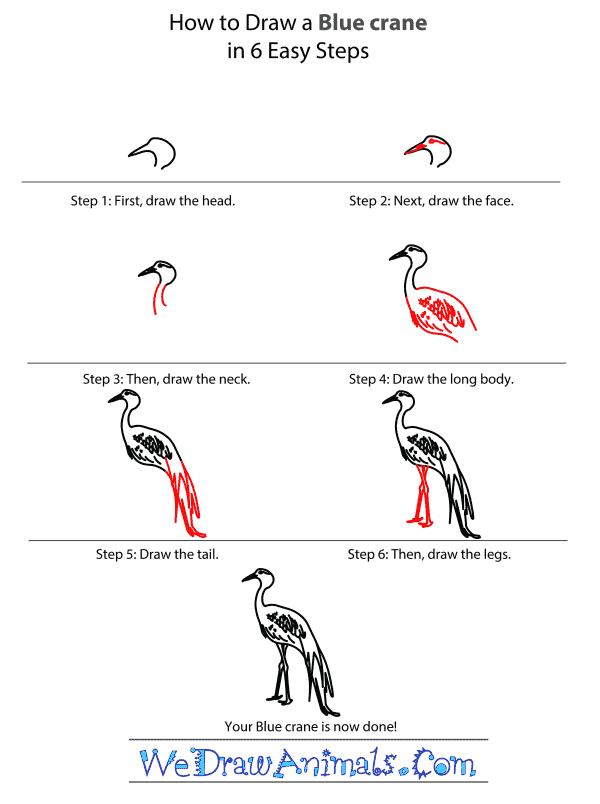In this quick tutorial you'll learn how to draw a Blue Crane in 6 easy steps - great for kids and novice artists.
The images above represent how your finished drawing is going to look and the steps involved.
Below are the individual steps - you can click on each one for a High Resolution printable PDF version.
At the bottom you can read some interesting facts about the Blue Crane.
Make sure you also check out any of the hundreds of drawing tutorials grouped by category.
How to Draw a Blue Crane - Step-by-Step Tutorial
Step 1: First, draw the head using a C-shaped line. The blue crane has a long thin beak which is perfect for digging through mud to find yummy roots and insects.
Step 2: Next, draw a line for the opening of the beak and a small circle for the eye. Draw a line from the top of the eye to the back of the head.
Step 3: Then, draw the neck by making a short curve from the back of the head and a longer curve from the beak that mirrors the other.
Step 4: Draw the long body using two lines to create a football-shape. To make the feathers create a cluster of U-shapes in the middle of your bird and four short lines at the bottom of the body for more feathers.
Step 5: The Blue crane is known for its long, elegant feathers. Create these by making two layers double points with the layer on top being shorter than the one underneath.
Step 6: Lastly, draw the legs of this very tall bird with each leg consisting of two lines that connect into three separate toes.
Interesting Facts about the Blue Crane
The national bird of South Africa, Blue Cranes are one of the small members of the crane family at about 3 or 4 feet tall and weighing 7 to 13lbs. They are only found in South Africa, giving them one of the smallest distributions of any crane even when they migrate. They are also very aggressive during their nesting season, attacking anything that comes too close including: people, cattle, tortoises, even small birds.
Did you know?
- Blue Cranes like to setup nests in grasslands and lay their eggs in the middle of the grass or on the bare ground.
- While the females incubate the eggs male Blue Cranes will spend their time defending the nest from intruders.
- Like other cranes the Blue Crane sometimes dance by flapping their wings, jumping, bowing and tossing grass to relieve stress.
- Blue Cranes are losing their habitat to timber production and accident poisoning.
Lesson plan note: Blue Cranes vary in color quite a bit with white to gray heads, various shades of light blue or gray feathers on most of their bodies, with tail feathers that are slate grey to black. Draw a Blue Crane then make copies for students and have them color in the crane themselves. After that put up all of the different cranes so they can see how diverse they are.







